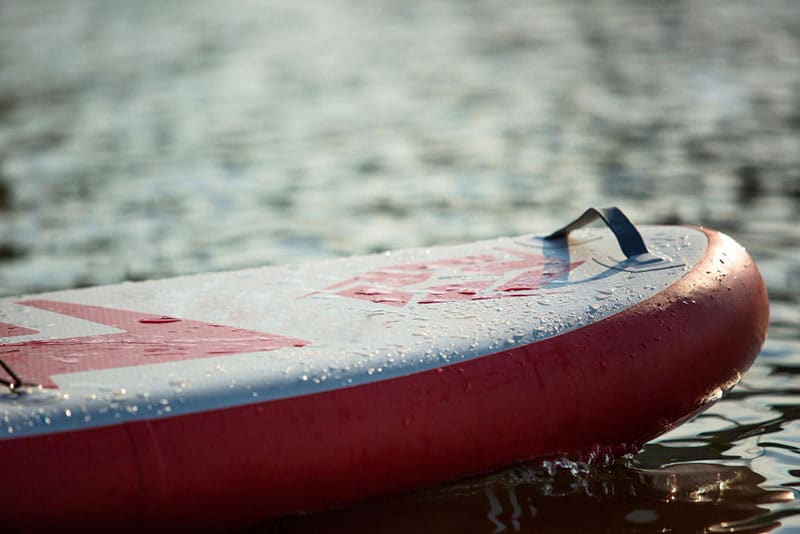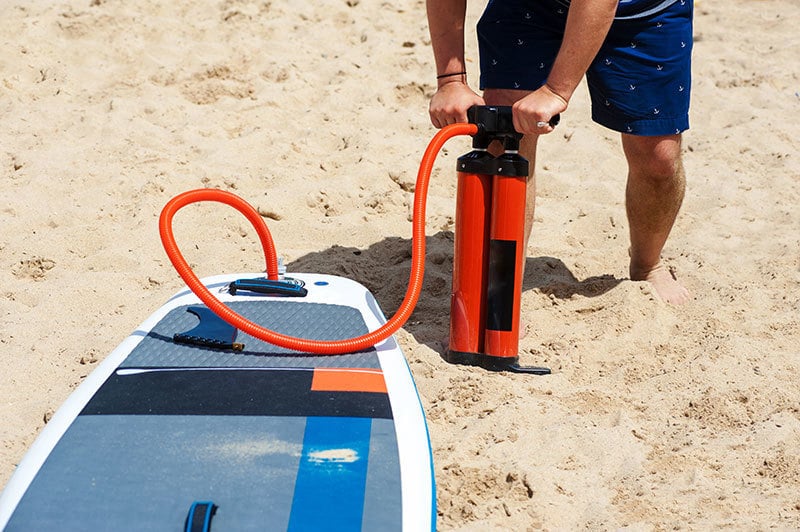The worst thing that can happen when riding on your inflatable paddle board is for it to lose air.
The simple answer is that there may be a puncture or cut in the paddle board, but the main thing to discuss here is how this happens.
In general, inflatable paddle boards are durable as they are made of military-grade materials that ensure they are strong and can withstand most circumstances.
However, this does not mean that they are not prone to getting damaged or wear and tear.
If you’re wondering ‘why my paddle board is losing air’, read on – we’ve got you covered!
4 Reasons Your Inflatable SUP is Losing Air
1. Losing air naturally
If you are new to owning an inflatable paddle board, you may notice that it’s losing air pressure.
Please note that this is quite normal.
Air escapes very easily from anything inflatable.
With your paddle board being stitched together at the seams as well as being made of PVC material, air will find its way out.
You may not even be able to tell when air has escaped from your board until after a few days or weeks, as it happens very slowly over time.
This is especially true if you are using it every day or keeping it inflated at all times.
Temperature changes may also be the reason for the change in pressure of your paddle board.
Heat levels rise in extreme heat and can cause expansion, whereas cool temperatures can cause the air levels to decrease.
Be sure to check inflatable SUPs before using them for a faulty seam or leaking air.
If it feels low, you can use a hand pump to get your board inflated fully.
2. Seam issues
Broken seams on inflatable boards may be another reason why you are losing air.
Glued seams can be prone to breaking over time, especially if you are using your inflatable paddleboard often.
This is not a problem when it comes to the hard paddle board and is thankfully not a very common problem with inflatable paddle boards either.
To fix this you should first use acetone to clean the area, then use PVC glue and PVC patches to patch it up.
When you have completed this process, you can pump your inflatable board up again and see if there is still air leaking.
To help you check, you can use soapy water – bubbles will form around the leak.
If you have just bought new inflatable SUP and the seams are damaged, send it back to the manufacturer.
Paying for shipping costs is better than having to purchase a new one.
3. A hole or tear
Punctures in inflatable paddle boards can also be the cause of air loss and are normally the most common reason.
Inflatable stand-up paddle boards are made with PVC material, which makes them extremely durable and less likely to get a hole or a tear.
But all of this does not mean that they cannot get damaged. Holes or tears can occur when your paddle board comes into contact with sharp objects.
This is usually easy to repair and can be done with the repair kit, PVC glue, and PVC patches.
If you are not able to do it yourself, take it to a repair shop or your local dealership.
4. Leaking valves or loose valves
All inflatable paddle boards have valves. This is where you connect a pump to fill it up with air.
In some cases, you may receive an inflatable paddle board with a loose valve or even a leaking valve.
If this does happen, use the valve wrench that comes in the repair kit to fix it.
Turning clockwise, tighten the valve on the inflatable SUP.
If it is not sealing properly, you may want to take it to a professional to replace the faulty valve with a new one.
FAQs
How long do inflatable paddle boards hold air?
There is no definitive answer to this question as it is completely dependent on the model of your inflatable SUP.
Some models can hold air in for longer than others.
If you are using your board very often then it may lose air faster.
To be safe, always travel with either a hand pump or electric pump.
How to maintain your inflatable paddle board?
Properly maintaining your paddle board will help it last longer and hold air better.
After using your board, you should rinse it off.
This will ensure there is no buildup of debris or salt water left on it.
It will also give you a chance to properly inspect your board for any leaks, holes, punctures, etc.
After your board has been washed and dried, you could either deflate it and then roll it up or keep it inflated.
If you choose to roll it up, make sure that you are not rolling it too tightly, as this could put pressure on its seams and lead to it bursting or tearing.
If you are keeping it inflated, make sure to store it in an area where it has enough space.
Do not store things on top of it either, as this could lead to it popping!
As long as you are not storing it under direct sunlight and in a safe space, you should not have to worry about it losing air.
Final Thoughts
As you can see, there are ways in which your paddle board can lose air.
But thankfully, most are easy to repair.
By following our tips above, you’ll be able to get your inflatable stand up paddle board back to full inflation in no time whenever it springs a leak.
Just remember, maintaining it well should stop any issues from arising in the first place.
Many paddle boarding adventures are waiting, don’t let losing air stop you from enjoying them!





